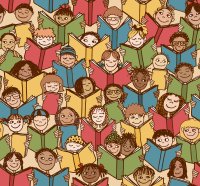Creating a Diverse Classroom Library
An interaction with a student prompts an elementary teacher to revamp her classroom library to make it more inclusive.
Your content has been saved!
Go to My Saved Content.The library is the physical and metaphorical center of my classroom. It is a reading world adorned with a carpet, comfy chairs, a lamp, and bins of neatly organized books. When I remember my own childhood, I picture a colorful tapestry woven by the hundreds of worlds I visited through the pages of books.
Imagine my surprise when one of my students commented about what I thought was a magical space, “I’m tired of reading about white kids.”
She followed this with a reminder that I, her teacher, am also not white. I was taken aback. More than 60 percent of my students are individuals of color. My library featured white characters almost exclusively. What schema was I helping to create for my students? I decided to make a change.
Start With What You Have
I began by making bins around the subjects I intended to cover. Make the bins you want to fill, even if they have only one book in them.
I already owned some books about characters from diverse ethnic backgrounds, but they were hidden—mixed in with other chapter books in bins marked with reading levels. I pulled every book out of the bins and made a pile on the floor. I weeded out books about people of color written by white authors and books that reinforce stereotypes, like The Indian in the Cupboard.
Look for topics that can be covered by your existing titles. You might need to start without much in the way of cultural diversity. Examples of such topics include Caring for Others, Be Yourself, Accepting Differences, Standing Up for What’s Right, and Girls Are Powerful.
Involve Your Students
One student took the first bin and labeled it Books About Asian Americans. It was followed by Books About African Americans. Per student requests, we made bins for a variety of cultural groups and labeled them Chinese American Girls, Native Americans, and Kids Who Recently Moved to the U.S.
Although the majority of bins were focused on ethnicity, students also made bins for themes and topics such as disabilities, different types of families, foster care, and divorce.
Ask your students to suggest books. Keep a list in your library and have students find books they want to read.
Choose Relatable Stories
We’re careful when choosing the books for the bins. I want contemporary books written about contemporary issues. I want students to feel proud and accepted—to see other children who struggle to find a voice, and who have dreams and challenges like their own. I carefully distinguish between realistic fiction and historical fiction.
Imagine if the only time you read a book about someone who looked like you, it was about slavery—and it was the only book in your classroom library to represent you. Or the book was about an internment camp. Yes, we need to remember this history. But these historical accounts should not be the only books that a student sees in the library that reflect his or her background.
Continue the Momentum
Creating a diverse library is an ongoing project. I found many diverse books at library sales and at secondhand stores like Goodwill. When I found multiple copies of the same book, I bought them all, including seven copies of Becoming Naomi Leon.
When it was time to replenish books through PTA or classroom funds, I made a concerted effort to buy culturally inclusive books. My library began slowly shifting. There are many resources to .
Make your space reflective of your intentions. In your library, get rid of decorations that do not have a function. Hang posters of African American writers, Native American poets, or Mexican American novelists.
Suggest that the school library start a special section for culturally inclusive books. I had many conversations with our school librarian about ways to build a more diverse collection.
Student Engagement and Self-Esteem
It was a big deal when our diverse classroom library began taking shape. Students took care of our bins and worked to find other books that could be included. Books previously unread—Year of the Dog, for example—were suddenly hot commodities. We had a waitlist for books by Pam Muñoz Ryan and Louise Erdrich.
Students began caring for books—holding each other accountable for returning them properly and for taking care of the organizational systems of our library. The classroom library was “our library.” It was a place of pride in our individual and collective stories.
“I think it’s good,” the student told me later when I interviewed her about our library. “It’s good except for...” and she pointed to the one book bin that was empty: Books About Girls From Senegal. That was a bin, she assured me with her bright grin, she was going to fill one day.
